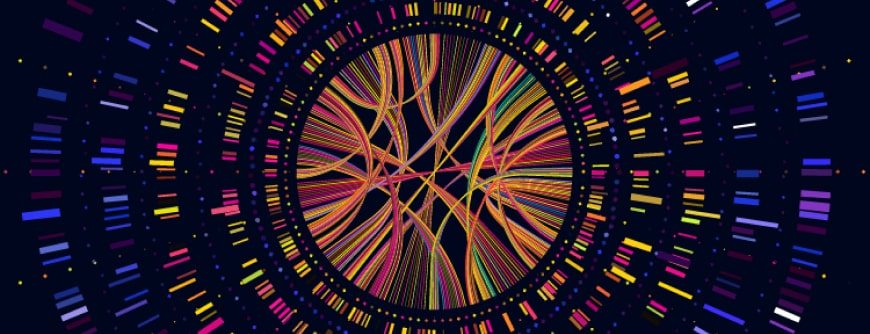Os dados de genômica são o produto combinado de uma rede em expansão de biólogos, geneticistas e cientistas de dados em todo o mundo. Esses cientistas e profissionais estão buscando respostas sobre a estrutura, função, evolução, mapeamento e edição de DNA, genes e genoma humano.
As descobertas que elas fazem estão levando a inovações na medicina, no controle de doenças e no armazenamento de dados. Os dados de genômica estão ajudando a comunidade científica a entender e desvendar as estruturas químicas do que torna a vida possível.
O que significa genômica?
Em resumo, genômica é um termo relativamente recente que se refere ao estudo de um genoma. Mas para descrever completamente a genômica e os dados de genômica, há quatro termos principais que devemos definir primeiro:
- Células
- DNA
- Genes
- Genomas
O que são células?
As células são os blocos de construção da vida. São unidades microscópicas que contêm todas as ferramentas necessárias para se potencializar e se reproduzir. Eles também podem trabalhar com outras células para criar ossos, sangue, músculos, pele e tudo o mais em nosso corpo. As células se constroem e agem de acordo com as instruções do DNA.
O que é DNA?
O DNA é um composto químico que contém todas as instruções que um organismo vivo precisa desenvolver. Diferentes seres vivos têm DNA diferente, mas os blocos fundamentais do DNA são quatro produtos químicos representados por quatro letras únicas.
- Adenina (A)
- Citosina (C)
- Guanine (G)
- Timina (T)
A estrutura do DNA é incrivelmente complexa. É semelhante a um livro, que tem milhões de letras combinadas em palavras, frases e parágrafos. Uma cópia do DNA humano contém 3 bilhões de combinações distintas das quatro letras que representam os blocos de construção do DNA. Praticamente todas as células do seu corpo contêm uma cópia do seu DNA, fornecendo dezenas de milhares de instruções sobre como criar genes.
O que é um gene?
Um gene é uma sequência específica e exclusiva da longa fita de DNA que cria traços que você pode herdar, como a cor dos olhos. Na biologia, o gene é considerado a unidade básica da hereditariedade.
Se o DNA é como todas as letras com as quais o corpo precisa escrever, um gene pode ser uma palavra. Algumas são mais curtas do que outras e outras têm efeitos mais complicados no corpo. Alguns genes têm algumas centenas de combinações de letras de DNA e outros têm mais de 2 milhões.
Estima-se que o corpo humano tenha entre 20.000 e 25.000 genes. O estudo dos genes é chamado de genética.
O que é genômica?
Genômica e genética são diferentes, mas estão relacionadas. A genética se concentra em genes individuais e na herança de traços, mas a genômica tenta caracterizar todos os genes de um organismo e como eles se inter-relacionam entre si e influenciam o corpo.
Um genoma é a coleta de todos os genes de uma pessoa reunidos. Se estamos pensando em genes como palavras, a genômica está olhando para todo o livro e entendendo como os capítulos, personagens e temas se relacionam entre si.
O que é análise de dados de genômica?
A análise de dados de genômica é um campo de estudo que depende de tecnologias computacionais para analisar e ajudar a visualizar o genoma e as informações sobre ele. A análise de dados de genômica inclui o processamento de grandes quantidades de dados na pesquisa de relações entre genes e, em seguida, o armazenamento não apenas de todos os dados brutos, mas também dessas relações e contexto.
Entender a genética e a genômica humanas requer muito mais do que descobrir que há 3 bilhões de combinações de quatro letras químicas em uma sequência ordenada específica (que aconteceu em 2003). A genômica também diz respeito a descobrir cada uma das quase 25.000 combinações dessas 3 bilhões de letras, o que elas fazem, como se relacionam e como interagem com o meio ambiente.
Uma das coisas interessantes na análise de dados genômicos é que nossa capacidade de visualizar e sequenciar as letras no DNA se desenvolveu mais rapidamente do que nossa capacidade de decifrar e entender o que as letras realmente fazem. Assim, a análise de dados genômicos é uma tentativa de pegar essa riqueza de informações que temos sobre a linguagem de nossos genes e traduzi-la em medicina e muito mais.
A análise de dados de genômica é um empreendimento enorme em mais de uma maneira. A análise de dados de genômica é um dos domínios de Big Data que mais cresce no mundo. A análise de dados de genômica pode gerar até 40 exabytes de dados até 2025. Para colocar o tamanho dos dados genômicos em perspectiva, se um gigabyte for o tamanho da terra, um exabyte será quase o tamanho do sol. Os dados genômicos seriam de 40 sóis.
Por que estudamos genômica?
A genética desempenha um papel crucial em muitas das principais causas de morte nos Estados Unidos. Doenças cardíacas, diabetes e câncer são todos causados por fatores que têm algo a ver com diferentes genes em nosso corpo e as relações entre eles. Estudamos genômica para tentar prevenir algumas das formas mais comuns de doença, enfermidade e morte.
A genômica nos ajuda a entender melhor como nossos corpos funcionam, o que pode ajudar mais pessoas a mantê-los funcionando melhor por mais tempo. Em termos genéticos, os seres humanos são 99,9% idênticos. Isso significa que as inovações genômicas para uma pessoa quase certamente se aplicarão a quase todos no planeta.
Por que é importante que os bancos de dados genômicos sejam compartilhados entre os pesquisadores?
É importante compartilhar dados genômicos e bancos de dados genômicos entre pesquisadores para que resultados mais precisos possam ser encontrados mais rapidamente. À medida que mais e mais pesquisadores exploram as relações entre genes e doenças, compartilhar essas descobertas e convidar outras pessoas a colaborar nelas pode levar a melhores resultados em conhecimento, produtos e procedimentos que melhoram a saúde humana.


